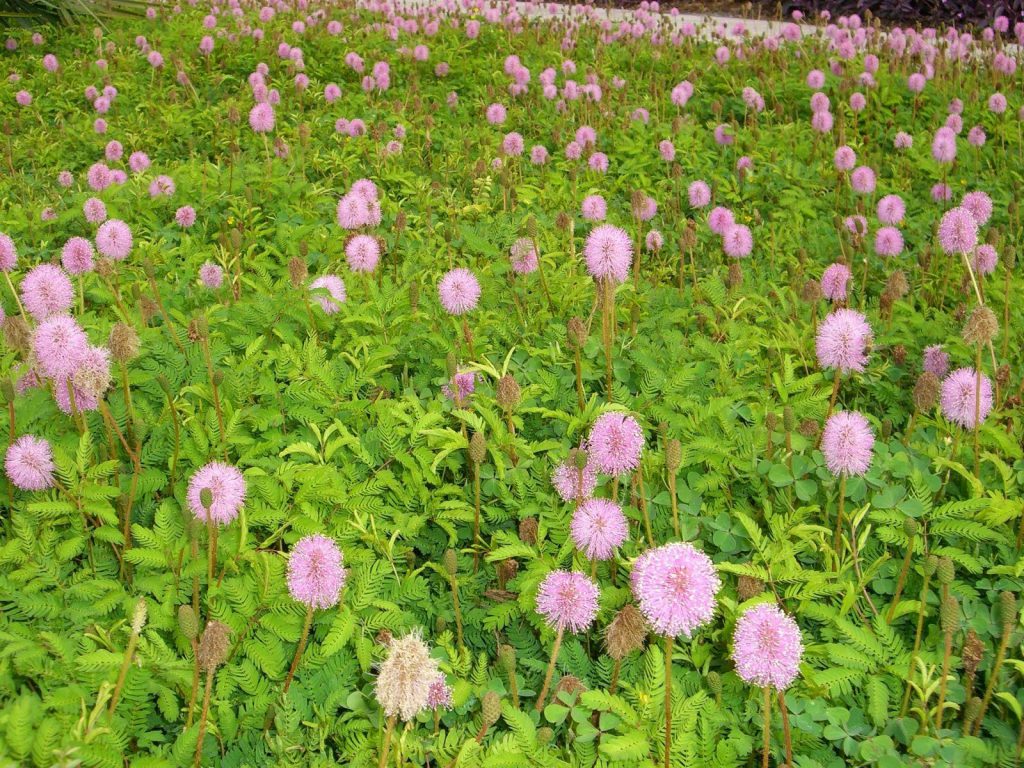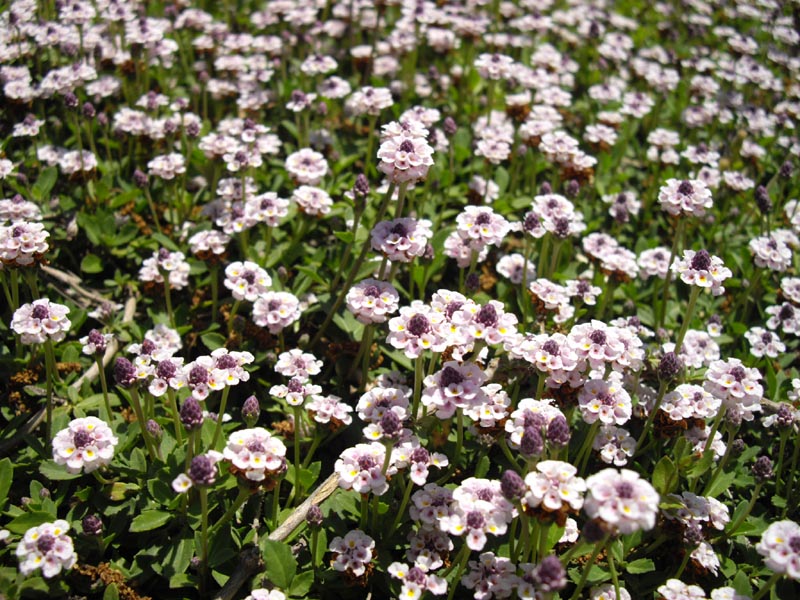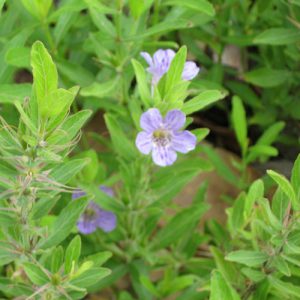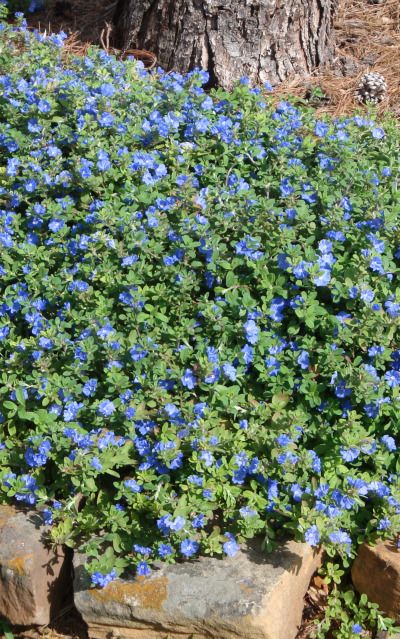A New Groundcover Appeal
Tired of the mundane? The ordinary? The boring? Landscapes stippled with the same plant material make me lose my interest in their designs. Nonetheless, let us think outside the normal plant palette. With the next gardening column series, let us explore some unique plants we could see more of and diversify the landscape.
For the series, we will start from the ground and work our way up. Starting with groundcovers, the subsequent articles will cover annuals/perennials, shrubs, and the trees to help diversify the landscape. Of course, this is not an exhaustive list. Following the Florida-Friendly Landscaping Program’s first principle, “Right Plant, Right Place” our only limitation is our environmental conditions, landscape function, and invasive plant material. These plants are a selection of my favorites.
The groundcovers we will discuss in today’s article include Sunshine Mimosa, Fogfruit, Twin Flower, and Blue Daze.
Sunshine Mimosa (Mimosa strigillosa)
Sunshine Mimosa, also known as Powderpuff Mimosa (Mimosa strigillosa) is a Florida native. It is a low-growing, nitrogen-fixing groundcover characterized by touch-sensitive leaves. When you touch the leaves its little leaflets fold-up. This groundcover grows rather quickly and produces beautiful pink puffballs that look similar to clover flowers. I recommend utilizing mimosa within landscapes where you need a very low groundcover and it can even tolerate some foot traffic. You may also interplant this within your turfgrass. Mimosa prefers full sun to partial sun landscapes. Once planted it is important to water them regularly. After establishment, the mimosa is a tough drought-tolerant plant for any Florida landscape. Be on the lookout too- the Sunshine Mimosa is a nectar source for butterflies.

Fogfruit (Phyla nodiflora)
Another beautiful groundcover is Fogfruit (Phyla nodiflora), which is also known as Turkey Tangle or Frogfruit. This time of year you will see this Florida native showing-off it’s small purplish-white flowers. Many homeowners view this as a turfgrass weed, but in fact, it is a wonderful groundcover that can add any appeal to a landscape. Fogfruit grows in full sun to partial shade and prefers to well-drained to partially drained soils, but does like regular moisture. This can be used a low-growing groundcover, in some cases as an alternative to turfgrass. Do not be surprised if you find multiple caterpillar species munching on Fogfruit. It is an important host plant for a few different butterfly species.

Twinflower (Dyschoriste oblongifolia)
Twinflower (Dyschoriste oblongifolia) is a year-round flowering native groundcover that grows to 6” to 12” in height. Growing throughout the state, this plant is great for an ornamental bed and creates year-round lavender flowers. This is an adaptable plant but prefers acidic soils and full sun location. This plant may seem thin in the landscape, so planting them closer together will help create a uniform planting that would make it a successful massing plant in your garden. Once planted in your landscape, you will notice it attracting many butterflies and bees.

Blue Daze (Evolvulus glomeratus)
Lastly, this non-native groundcover is a great massing plant for your landscape. Blue Daze (Evolvulus glomeratus) is a low-growing groundcover with pale blue-green leaves and striking blue flowers. As an adaptable plant, you can plant Blue Daze as a massing plant or container plant in your landscape. You can plant Blue Daze in most soil conditions that are in full sun or partial shade. Alachua County’s colder winters could cause Blue Daze to dieback, but it will quickly grow back once warmer temperatures return. Lastly, monitor regularly during our rainy season, Blue Daze can suffer from root rot within poorly drained soils.

Conclusion
Our landscapes offer wonderful locations that provide benefits to wildlife and offer high aesthetic quality. As we diversify the landscape with our plant material choices, we create a wonderful spectrum of landscape designs that appeal to almost everyone. Of course, I am only pointing out four examples of groundcovers that we can use more of within our landscapes, but the list is nearly limitless under the principles of the Florida-Friendly Landscaping Program. What other groundcovers do you like to use within your landscape that are not mentioned here? Please let us know.
Interested in more gardening-related blogs or following Alachua County’s MGVs on Social Media? Check out the additional links from Dr. Clem.
UF/IFAS Alachua County Extension Master Gardeners, Facebook Page
UF/IFAS Extension Alachua County YouTube Page
 1
1

Comments:
October 18, 2021
Hi Lane, I attached some information via email. Thanks
October 17, 2021
I think I know the answer to this but can you confirm that growing crops in a hydroponic system can not be sold, even at a farmers market, unless that land is categorized as agricultural or if you fall into the "limited use" category, which I believe that requires atleast a single acre of land? If this is correct, do you know if there is any exemptions, as my property would not qualify for limited use, as it's only a half acre. I'm just trying to sell my produce at farms markets as a side business! Thanks for any advice, feedback you can give.
March 30, 2021
You certainly can try to sprout them. You will have a far far greater germination rate if you cold stratify the seed first. Its a very simple process that just requires a wee bit of patience.
March 29, 2021
I’m curious about the cold germination. I’m in zone 10 and the pods are opening. Do I need to do this cold germination process or can I just try to sprout them? Thank you.
March 24, 2021
You are right, good catch! Many of the gardens during the Renaissance Period had varying underlying principles/theories. Le Notre definitely created the synthesized definition of French Classical Gardens, starting with Vaux-le-Vicomte, which definitely had Renaissance/Baroque garden influences. One major difference I've always liked was the use of theatrical perspectives within gardens (focal points, unification around one plane/frame, and use of planes to influence depth) and Mollet's influence on parterres. Of course, the French-style gardens were substantially more grandiose than the Italian Renaissance for purposes of pleasure, entertainment, conducting court, etc, but focused much on absolutism. I'd love for you to send me some additional resources because it is hard to find them. You can send me a direct email to taylorclem87@ufl.edu Thank you.
March 23, 2021
The Gardens of the Palace of Versailles is not a Renaissance Garden. It is instead a French Classical Garden, which held quite strongly opposing values of the renaissance ideals. It was not even in close proximity with the Renaissance period.
January 12, 2021
Thank you for your great question. We have lots of materials and resources available online for homeowners. The Gardening Solutions webpage is a great webpage for all homeowners (www.gardeningsolutions.ifas.ufl.edu). We also have a county webpage dedicated to the Florida-Friendly Landscaping Program that includes additional resources (https://sites.google.com/ufl.edu/alachuaffl/home). Regarding services, we offer programs throughout the year relating to landscaping best management decisions and vegetable gardening. I recommend checking out our county’s programs/events page for all our upcoming programs (https://sfyl.ifas.ufl.edu/events/?location=alachua). Other services we provide include our Master Gardener Volunteer Help Desk. You can reach out to our Master Gardeners Volunteers via email (mag@alachuacounty.us)or phone (352)955-2402 to help troubleshoot any issues within your landscape or garden. Also, the Master Gardeners perform Florida-Friendly Landscape Recognitions. Volunteers visit a homeowner’s property and do a landscape evaluation. This free evaluation allows homeowners to learn ways to improve their landscapes and potentially earn a Gold or Silver landscape recognition. Taylor Clem, PhD Environmental Horticulture Extension Agent UF/IFAS Alachua County Extension 106 SW 140th Terr. Suite 3 • Newberry • FL • 32669 955-2402 (office)
January 8, 2021
Is there any documentation, preferably online, that defines and lists the availability of services for homeowners and those planning on planting beneficial plants on their property?
October 6, 2020
I recommend reaching out to our office. Dr. Cindy Sanders is our county's livestock agent and she will be able to answer your question and give recommendations. Feel free to call us from (352)955-2402
August 23, 2020
I would like to know if horses can Eat sunshine mimosa
August 3, 2020
Great Blog! Looking forward to more!
July 9, 2020
Genevieve, Thank you for reaching out. We have quite a few publications that can help you out! Here are a couple articles from UF/IFAS Extension relating to butterfly gardening and attracting wildlife to your landscape. If you'd like further information, feel free to reach out to our office at (352)955-2402 or email our Master Gardener Volunteer help desk at mag@alachuacounty.us. Butterfly Gardening in Florida: https://edis.ifas.ufl.edu/pdffiles/UW/UW05700.pdf Landscape Backyards for Wildlife: https://edis.ifas.ufl.edu/pdffiles/UW/UW17500.pdf
June 19, 2020
Interested in plants that are easy, come up each year. attract butterflies and humming birds
May 27, 2020
Good morning, Thank you for reaching out to UF/IFAS Extension Alachua County. I'll forward your question to our Livestock Agent, Dr. Cindy Sanders. She'll be able to give you the best recommendations regarding your pasture. Thank you, Taylor Clem
May 26, 2020
I'm in Alachua county and over the years Sunshine Mimosa has spread across quite a bit of my bahia grass horse pasture. It's intermixed with the grass. I'm not finding anything that says it's toxic to horses but I don't think my horses eat it. I think I could control it with herbicide but am hesitant because it is always covered with honey bees and native bees. Is this something I should try to control? Is there a danger that it will choke out my pasture?
April 27, 2020
Monarchs caterpillars only eat milkweed, and the butterflies only lay eggs on milkweed.
April 23, 2020
I have counted as many as 30 monarch (and queen) caterpillars munching happily on my Giant Milkweed. Later I discovered more than 15 spent chrysalis in the cat palm growing beside it.
April 20, 2020
Hi Carlos, I recommend always to follow science-based information, shadow a beekeeper and have the opportunity to learn some about the biology and principles of honeybees before any major investment. Keep in mind that keeping bees in Florida is different from keeping bees in other areas so try to learn from resources that are focused at least to the South East. The beekeeping series offered in Alachua County is a good place to start, the next series cycle starts in November. I also recommend Bee College and the Master Beekeeping program at UF. You can do it online or face-to-face (annual event). You can check it out at http://entnemdept.ufl.edu/honey-bee/extension/master-beekeeper-program/. If you have specific questions on these programs you may contact Amy Vu at amy.vu@ufl.edu. Lastly, you can contact the Gainesville Area Bee Club and join them to meet other beekeepers and learn about others' experiences (https://www.gainesvilleareabeeclub.com/). Here are some recommended sources for you to start exploring beekeeping: - http://entnemdept.ufl.edu/honey-bee/beekeeper-resources/ - https://impact.extension.org/?s=beekeeping - https://honeybeehealthcoalition.org/
April 18, 2020
Hello I would like to start with bee keeping!! Any advise ?
April 16, 2020
Hello do Monarch caterpillars eat only milkweeds leave or will they ravage my entire garden?
April 14, 2020
James, There are different types of turfgrass species, but finding a specific species that are good for sun and shade is difficult. Seville St Augustine and Empire Zoysiagrass are the most shade-tolerant turfgrasses, but they still need a good amount of sun. Areas directly under trees won't typically develop a good turf stand. The best strategy for managing turfgrass is following IFAS recommendations for growing turf in shadier conditions. If you would like to get more information, email me at taylorclem87@ufl.edu. Also, we have an upcoming webinar on turfgrass management on April 23 from 4 - 5:30pm. You can register and see more information here: https://www.eventbrite.com/e/turfgrass-in-alachua-county-tickets-102293845646 Thank you very much, Taylor Clem Environmental & Community Horticulture Agent UF/IFAS Extension Alachua County.
April 6, 2020
I am looking for a grass to replace my St. Augustine which has been eaten by chinch bugs. I have both full sun and full shade areas. My yard is now almost completely covered by sand burs. Is there one grass for both shade and sun? I am a disabled vet and mowing the grass is about the limit of the yard work I can do.
March 17, 2020
I'm guessing the March 19 event is cancelled. However, if you had handouts about planting edible plants, would you either post them or email them to me? Thanks!
February 4, 2020
Thank you so much for your article. I am a firm believer in Companion planting.
June 5, 2019
I recently purchased a giant milkweed plant. I had never heard of it before. Do monarch caterpillars like it as much as regular milkweed? Thanks!
July 11, 2018
Dam awesome Kevin. I'm proud of you!
June 12, 2018
Hi Dave - I would, as carefully as possible, transplant. Ideally you would want to wait until your plants are roughly 3 inches tall. You may still want to wait with 1/2 of your plants. I just don't know if your plants will make that size given you germinated in egg cartons. You could also cut the egg cartons apart & just transplant the whole thing. The egg cartons should decompose. Good Luck.
June 12, 2018
I have planted 6 varieties of .milkweed from seeds in paper egg cartons after 30 days in the fridge. Germination went well. I have about 20 young seedlings about 3/4 to an inch high. Should I get them out of the cartons and into pots now or wait til they're bigger? Thanks
June 1, 2018
Santa Rosa Gardens, a mail-order company in Pensacola, Florida has incarnata and tuberosa. The website is santarosagardens.com. Tell them Louise from the Panhandle Butterfly House sent you. They are a great company.
Comments are closed.